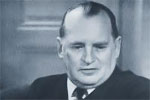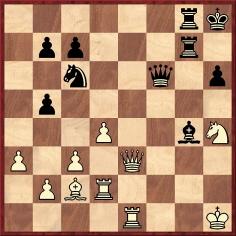


Over the past couple of years Charles Sullivan (Davis, CA, USA) has raised with us a number of questions, often difficult, about the accuracy of some Alekhine game-scores, based on their appearance in the huge book Alexander Alekhine’s Chess Games, 1902-1946 by Leonard M. Skinner and Robert G.P. Verhoeven (Jefferson, 1998).

In C.N. 5429, for example, Mr Sullivan asked about the last-round game Alekhine v Salwe, Hamburg, 6 August 1910, which is given as follows on pages 51-52:
1 d4 d5 2 Nf3 Nf6 3 c4 e6 4 Bg5 Be7 5 e3 b6 6 Nc3 Bb7 7 cxd5 Nxd5 8 Bxe7 Qxe7 9 Bb5+ c6 10 Bd3 Nd7 11 O-O O-O 12 Rc1 Rfc8 13 Qd2 c5 14 Nxd5 Bxd5 15 e4 Bb7 16 Qe2 cxd4 17 Nxd4

17...Ne5 18 Rfd1 g6 19 f3 Kh8 20 Kh1 Kg8 21 Kg1 Kh8 22 Kh1 Kg8 Drawn.
Mr Sullivan wrote:
‘If the game-score is correct, the last five moves by Alekhine (starting with 18 Rfd1) are blunders which would lose a piece to, for example, 18...Rxc1 19 Rxc1 Rd8. Can you shed any light on this?’
We commented that the Skinner/Verhoeven volume reproduced the game, faithfully, from pages 147-148 of the Hamburg, 1910 tournament book, but we wondered whether Black’s 17th move was 17...Nc5 rather than 17...Ne5, as the remainder of the game would then make more sense. 17...Nc5 was, in fact, the move given on page 122 of Alexander Alekhine I Games 1902-1922 (Sofia, 2002), but we have yet to find this short draw in any contemporary source other than the tournament book.
In C.N. 5693 Mr Sullivan turned to the game E. Znosko-Borovsky v Alekhine, St Petersburg, 27 January 1914, as included on pages 92-93 of the Skinner/Verhoeven volume.

After 34 Rh2 Ne7 35 Ng2 Rg5, instead of 36 Be4 White could have won a piece with 36 Qxe7, and our correspondent therefore wondered whether the game-score is correct, and whether the move-order was perhaps 34...Rg5 35 Be4 Ne7 36 Ng2 c6.
Unable to trace the game in any 1914 source, we contacted Leonard Skinner (Cowbridge, Wales), who kindly forwarded the earliest publication of the game known to him (as included in his book): Alekhine’s notes on pages 209-212 of Shakhmatny Vestnik, July 1915. The relevant phase is reproduced below:


Given that the Skinner/Verhoeven book reproduced the game-score accurately, the question is whether an oversight occurred at the board at move 36 or whether Alekhine erred in the move-order which he submitted to the Russian periodical.
Tarrasch v Alekhine, Hastings, 18 September 1922 was the game featured in C.N. 5495. Alekhine annotated it on pages 45-47 of his tournament book (published in London in 1924); in the Dover reprint (New York, 1968) the page numbers are 41-43. See also pages 172-173 of the Skinner/Verhoeven volume on Alekhine. The first part of the game is as follows: 1 e4 e5 2 Nf3 Nc6 3 Nc3 Nf6 4 Bb5 Nd4 5 Nxd4 exd4 6 e5 dxc3 7 exf6 Qxf6 8 dxc3 c6 9 Bd3 d5 10 O-O Be6 11 Qh5 Be7 12 Be3 c5 13 Bb5+ Kf8 14 Be2 h6 15 Qf3 Qxf3 16 Bxf3 Rd8 17 Rfd1 g5 18 g3 h5 19 Rd2 g4 20 Bg2 h4 21 Rad1 hxg3 22 hxg3 Rh5 23 f4 b6 24 Kf2 Bf6 25 a3 Kg7 26 Kg1 Re8 27 Kf2 Reh8 28 Kf1 Rd8 29 Kg1 a5 30 Kf2 Be7 31 Kg1 Bf6 32 Kf2 Rd7 33 Rh1 Rxh1 34 Bxh1.
Mr Sullivan asked whether the game-score in these sources is faulty, as Alekhine would have been unlikely to miss the opportunity in the position below (after 34 Bxh1) to win the white bishop with 34...d4.

Our comment was that we suspected (but could not prove) that there was indeed an error in the game-score. When moves 1-37 were published on pages 36-37 of the November 1922 Chess Amateur Black’s 32nd move was given as ...Re8 and not ...Rd7. In that case, the position after 33 Rh1 Rxh1 34 Bxh1 would not give the possibility of winning the bishop. An alternative explanation is that at move 32 Alekhine played ...Rd6. That is the move given on page 378 of Alexander Alekhine I Games 1902-1922.

Siegbert Tarrasch
Alekhine v Turover, Bradley Beach, 3 June 1929 is on pages 359-360 of the Skinner/Verhoeven book.

Play is said to have continued 21 Qxe5 Qxe5 (after 1 Nf3 d5 2 c4 c6 3 b3 Nf6 4 Bb2 Bf5 5 g3 e6 6 Bg2 Be7 7 O-O Nbd7 8 cxd5 cxd5 9 Nc3 O-O 10 d3 Rc8 11 Qd2 Qa5 12 a3 Qb6 13 b4 a5 14 bxa5 Qxa5 15 Rfd1 b6 16 Nd4 Bg6 17 e4 dxe4 18 Nb3 Qf5 19 Nxe4 Ne5 20 Qf4 Nxe4), and in C.N. 5333 Mr Sullivan wondered whether both players overlooked 21...Qxf2+, which wins for Black.
We remarked that the book gave two sources for this game: the Brooklyn Daily Eagle, 13 June 1929, page 32, and the American Chess Bulletin, July-August 1929, pages 130-131. Although we did not have the newspaper, it could be noted that according to the game-score in the Bulletin Black’s queen stood at h5, not f5 (18...Qa5-h5).
In C.N. 5337 Leonard Skinner wrote:
‘I have looked again at my print of the Brooklyn Daily Eagle, and it seems that I misread Black’s 18th move. It should be 18...Q-R4 (Qh5). Because of the state of the microfilm in the Library of Congress my print was not as good as one might want, so I originally took the move to be 18...Q-B4, i.e. Qf5.’

Alexander Alekhine
In C.N. 5354 Mr Sullivan raised the subject of Alekhine v Nowarra, Cracow, 17 October 1941, as given on page 670 of the Skinner/Verhoeven book.

Our correspondent asked whether, after 52 Qe6+ Rc6, Alekhine really overlooked 53 g8(Q), which wins at once.
We noted that the book’s source was pages 172-173 of the November 1941 Deutsche Schachzeitung:
It will be seen that Heinz Nowarra provided notes, and that the game-score corresponds to what appeared in the Skinner/Verhoeven book. However, a correction to the score was published on page 181 of the December 1941 magazine, where ‘M.B.’ (Max Blümich) indicated that White’s 52nd move was Qd6+, not Qe6+:
The final position arose in Sämisch v Alekhine, Prague, 15 December 1942 (page 696 of the Skinner/Verhoeven book):

The continuation in the book is 26 Nxa7 Bg5, and in C.N. 5333 Mr Sullivan queried whether both players really missed 26...Ra8, which wins the knight.
Here, the source specified by Skinner and Verhoeven was page 51 of the Lachaga booklet Prag, 1942 (Martínez, 1973). We checked the score in another book (also listed in the bibliography, on page 790): Durasův turnaj – Praha 1942 by Karel Průcha (Prague, 1943). It too had the same sequence (1 e4 e5 2 Nf3 d6 3 d4 Nd7 4 Bc4 c6 5 a4 h6 6 Nc3 Be7 7 O-O Ngf6 8 Qe2 Qc7 9 Rd1 Nf8 10 dxe5 dxe5 11 Ne1 Ne6 12 Bxe6 Bxe6 13 Nd3 O-O 14 Be3 b6 15 h3 c5 16 f4 exf4 17 Nxf4 Qe5 18 Nd3 Qh5 19 Qxh5 Nxh5 20 g4 Nf6 21 Nf4 Rad8 22 Rxd8 Rxd8 23 a5 Bc8 24 Nb5 Nxe4 25 a6 Bd7 26 Nxa7 Bg5). We commented that before concluding that there was indeed a double blunder by Sämisch and Alekhine, we should like to know what moves were given in any other publications of the time. The game (drawn at move 41) is absent from the various Czech and German sources available to us.

Alexander Alekhine
A review by us of the Skinner/Verhoeven volume was published on pages 75-78 of the 4/1998 New in Chess.
In conclusion, we thank Charles Sullivan for a stimulating set of questions. Where no satisfactory answers have yet been found, readers’ contributions will be particularly appreciated.
Submit information or suggestions on chess explorations
All ChessBase articles by Edward Winter
 Edward
Winter is the editor of Chess
Notes, which was founded in January 1982 as "a forum for aficionados
to discuss all matters relating to the Royal Pastime". Since then, over 6,300
items have been published, and the series has resulted in four books by Winter:
Chess
Explorations (1996), Kings,
Commoners and Knaves (1999), A
Chess Omnibus (2003) and Chess
Facts and Fables (2006). He is also the author of a monograph
on Capablanca (1989).
Edward
Winter is the editor of Chess
Notes, which was founded in January 1982 as "a forum for aficionados
to discuss all matters relating to the Royal Pastime". Since then, over 6,300
items have been published, and the series has resulted in four books by Winter:
Chess
Explorations (1996), Kings,
Commoners and Knaves (1999), A
Chess Omnibus (2003) and Chess
Facts and Fables (2006). He is also the author of a monograph
on Capablanca (1989).
Chess Notes is well known for its historical research, and anyone browsing in its archives will find a wealth of unknown games, accounts of historical mysteries, quotes and quips, and other material of every kind imaginable. Correspondents from around the world contribute items, and they include not only "ordinary readers" but also some eminent historians – and, indeed, some eminent masters. Chess Notes is located at the Chess History Center. Signed copies of Edward Winter's publications are currently available.